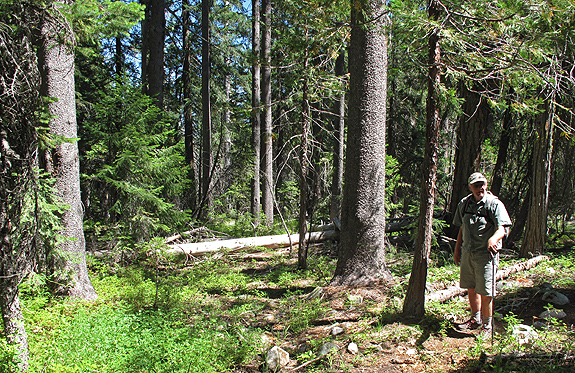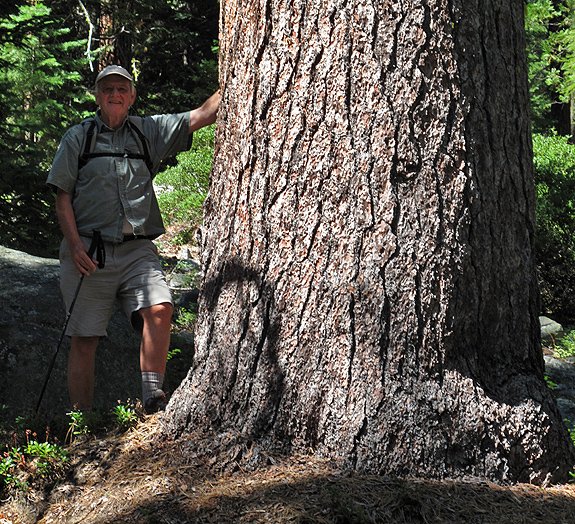Russian Wilderness, California
Original Publication DATE: 8/31/2011
In the late 1960’s, after arriving at Humboldt State University as a new professor, John O. Sawyer received a letter in the mail from G. Ledyard Stebbins. Stebbins, widely regarded as one of America’s leading evolutionary biologists but also a lover of rare plants, suggested to John that he needed to visit a remote place in the Klamath Mountains known as Blake’s Fork. Here, he said, John might help verify a report for one of California’s rarest conifers–the Engelmann spruce. Stebbins hoped John could record his findings in a new database called the Inventory of Rare and Endangered Vascular Plants of California organized by the California Native Plant Society. With conifers calling, John and his friend and co-worker Dale Thornburgh went on a journey that would change our understanding of conifer distributions, plant associations, and wilderness in California.

Upon a successful trip to Blake’s Fork, John and Dale had become enchanted with the Salmon Mountains. They wanted to see more and went about planning for it by referencing botanical databases. They found that Engelmann spruce had also been documented along Sugar Creek, just over the Salmon Crest from Blake’s Fork. In the summer of 1970 they walked up Sugar Creek and documented plants along the way, eventually finding themselves climbing up the south-facing ridge above Sugar Lake (where they saw foxtail pines) and into the Little Duck Lake Basin. While at the south end of the lake Dale properly identified the first subalpine fir in California (though it took him half and hour to convince John!). Around the campfire maps came out and lists were made. They determined that in a roughly drawn square mile–encompassing the ridges and valleys around Little Duck Lake–there were 17 species of conifers. The ‘Miracle Mile’ was born. The drainage around Russian Peak hold one of the richest conifer assemblages on Earth*.
*An undocumented report of 17 conifers in a square mile around Crystal Peak in Mount Rainier National Park has recently been made

In the coming years John and Dale were funded by the Forest Service to survey for plants in many of the drainage along the Salmon Crest above the Scott Valley. Ultimately, with the help of graduate students, they documented over 400 species of vascular plants in Sugar Creek alone5. This extensive research led to a unique understanding for these forests. Clearly the area needed a level of preservation beyond that of just National Forest. In the following years, through their dedication to this goal, the region was well preserved. A few affects of their research include:
- Designation status of Roadless Area Review and Evaluation (RARE 1 and 2) after the signing of the 1964 Wilderness act. This ensured the area remained on the radar for future wilderness designation even though it was not included in the original act.
- Designation as the Russian Wilderness in 1984. John was consulted throughout the process by Representatives from northwest California while they sorted through the bureaucratic motions. Ultimately the deal went down when a land swap was negotiated wherein higher elevation less productive forest was traded for lower elevation more productive forest (probably full of giant sugar pines). Though the Forest Service had originally proposed to build a road and drive-in campground a Little Duck Lake, the Russian Wilderness was preserved.
- Designation of Sugar Creek Research Natural Area.
- Designation of the Duck Lake Botanical Area.
18th Conifer in the Miracle Mile?
This summer John heard another conifer had been found in the Miracle Mile. I thought it must be knobcone pines (Pinus attenuata) but the report was for western junipers (Juniperus occidentalis) on the south-facing slopes above Sugar Creek. Could he and Dale have missed a conifer? With the need to know we returned to search and document this past weekend. After spending several hours beating up the south-facing hillside through montane chaparral (and cutting my legs numerous times on Arctostaphylus patula) I found no evidence of western junipers, though it appeared to be ideal habitat. Western junipers grow just east of Sugar Creek in the Scott Valley, so it is quite possible seeds could have been dispersed here by a bird (maybe a Townsend’s solitaire?). Could it be I missed them because of the route I chose up the steep slope? Surely this is but one reason to adventure again in Conifer Country.

UPDATE – DOCUMENTATION OF 18th Conifer!
A list of conifers within the Miracle Mile:
- foxtail pine
- whitebark pine
- western white pine
- Jeffrey pine
- ponderosa pine
- lodgepole pine
- sugar pine
- white fir
- Shasta fir
- subalpine fir
- Engelmann spruce
- Brewer spruce
- mountain hemlock
- Douglas-fir
- Pacific yew
- incense-cedar
- common juniper
- western juniper – document by Richard Moore in 2013
More to Explore
- Keeler-Wolf, T. 1984. Vegetation map of the upper Sugar Creek drainage, Siskiyou County, California. Unpublished report on file, Pacific Southwest Research Station, Albany, Calif.
- Sawyer, J. O.; Thornburgh, D. A. 1969. Ecological reconnaissance of relict conifers of the Klamath region. Report to Pacific Southwest Forest and Range Experiment Station, Berkeley, California. PSW COOP-AID Grant #7. Unpublished report on file, Pacific Southwest Research Station, Albany, Calif.
- Sawyer, J. O.; Thornburgh, D. A. 1970. The ecology of relict conifers in the Klamath region, California. Report to Pacific Southwest Forest and Range Experiment Station, Berkeley, California. PSW COOP-AID Grant #9. Unpublished report on file, Pacific Southwest Research Station, Albany, Calif.
- Sawyer, J. O.; Thornburgh, D. A. 1971. Vegetation types on granodiorite in the Klamath Mountains, California. Report to the Pacific Southwest Forest and Range Experiment Station, Berkeley, California. PSW COOP-AID agreement supplement #10. Unpublished report on file, Pacific Southwest Research Station, Albany, Calif.
- Sawyer, J.O. 2006 Northwest California. University of California Press. Berkeley, Ca.
- Eds. Barbour M.G., T. Keeler-Wolf, and A.A. Schoenherr. 2007. Terrestrial Vegetation of California, 3rd edition. University of California Press, Berkeley.
COMMENT:
AUTHOR: Joyce Grunewald
DATE: 9/1/2011 12:00:20 AM
The “Russian Peaks” look like the Yellow mountains in China.
—–
COMMENT:
AUTHOR: Gambolin’ Man
URL: https://gambolinman.blogspot.com
DATE: 9/1/2011 12:39:45 AM
Excellent post!
—–
COMMENT:
AUTHOR: Rebecca Schenone-Chase
DATE: 6/10/2013 7:31:44 PM
Yesterday i rode my horses with a few friends up the new official Sugar creek lake trail head the CCC crew is finishing up. I just found out about THE MIRACLE MILE recently. I own a historic ranch in the valley below and i look at MY mts daily. I always have loved riding to the Ducks lakes and Statue Lake but this is a rare gem. I am a retired Ranger so this is even more special to me. I always appreciated the Brewer spruce but to see small groves of them is something. The only other places i had seen some was up on the trail at castle crags. my good friend was on the original study done years ago and she and her husband are also local packers, she had lots to tell me, soo I had to see for myself..WOW am I lucky to live in the valley below . Stewardship of all of this is soo important!!! Our fear is especially amplified with drought conditions this year – we will loose these special places ….
—–
COMMENT:
AUTHOR: Michael E. Kauffmann
DATE: 6/10/2013 8:16:41 PM
Thanks Rebecca- you certainly do live in a special place!
—–
COMMENT:
AUTHOR: Lorrie Bundy
URL: https://www.lcpackers.com
DATE: 6/24/2013 5:53:29 PM
Thanks for posting info about this special place. We were lucky enough to host a Jepson Herbarium workshop at Little Duck in 2011 with John Sawyer as a guest speaker. Your book was not published yet and many workshop participants were anxiously waiting for its release! Richard Moore was one of our camp volunteers. How great that you were able to document another species!
—–
COMMENT:
AUTHOR: Michael E. Kauffmann
DATE: 6/25/2013 12:29:51 PM
Lorrie- Thanks for sharing. I remember John calling me after the workshop, giddy, and telling me about what Richard had relayed about the junipers. I’m so glad Richard got in touch with me, after his brother bought Confer Country for him, to tell me where the trees were. Great adventure for sure!
—–
COMMENT:
AUTHOR: Marla Knight
DATE: 6/25/2013 6:02:55 PM
I’ve enjoyed reading all your blogs. This IS a very special area which we value quite highly. You may not have heard, but Dr. Thornburgh also passed away recently, in February. You can google for his obituary. He and Dr. Sawyer contributed the lions share of information leading to the protection of this special place. May they both rest in peace.
—–
COMMENT:
AUTHOR: Michael E. Kauffmann
DATE: 6/26/2013 2:58:24 AM
Thanks Marla- I did know about Dale. In fact, I saw his wife Pat just the other night and we talked about the Miracle Mile and the “new” conifer. She was very happy to hear about the discovery.


thanks for the great post! Sawyer was my major professor, focusing on whitebark pine – and i spent many days/nights with him and Dale traipsing through the wild country, including this spot at LDL (of course…). Also of interest and almost comparable in diversity is the area from Trout Camp to Devil’s punchbowl – totally different assemblage of diverse conifers – keep up the great work!
I live on Sugar Creek and often times hike near Sugar Lake . Yesterday on my hike I took a picture of a conifer that was quite different from the others.I have a app called picture this and it identified it as European Larch . Is this right or could it be another conifer ?
Brian- I’d love to see a picture because there are no native larch in California. Maybe a sugar pine?